Episode 1: History of the Old Davie School
Click play to listen! Or subscribe and listen on Spotify, Apple Podcasts, YouTube and other platforms!

The following is the transcription of the first episode of “Old School: A Podcast from the Old Davie School Historical Museum.”
Hello everybody! Welcome to Old School, a podcast from the Old Davie School Historical Museum! I’m Kim, the Education Director here at ODS and the best way to kick off the Old School podcast’s very first episode is telling the story of the old school!
Education on the Frontier
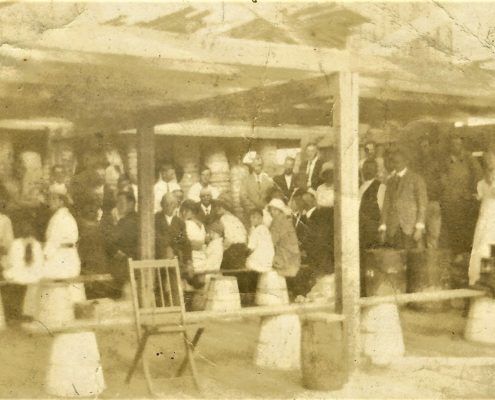
Meeting in a Davie Packing House, mid 1910s. Notice the turned over potato hampers and plank of wood as a bench!
Education always played an important role for the community in Davie. As soon as families began arriving around 1910-1911, they found a place for their students to learn. Some of the first classes were held in the vegetable packing houses with overturned potato hampers and a plank of wood on top as benches. This is also how they did town meetings and church on Sunday.
School was also held in one room of the General Store with all the kids sharing one space and one teacher together. Mrs. Althea Jenne, a much beloved teacher and principal at the Davie School, began teaching in these makeshift classrooms on the frontier in 1912. She would go on to teach at the Davie School throughout her career until her retirement in 1946.
The town knew they needed more space for students, so a two-room wooden schoolhouse was built in 1914 on a 5-acre plot of land donated by the Everglades Land and Sales Company, which was R.P. Davie’s company, where we get the name for the Town of Davie! The structure had screened windows and porches and by November 1914, there were already 53 students, so it was a big, bustling two rooms for the community.
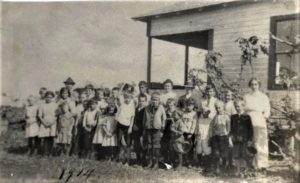
Students in front of the two-room wooden school building, 1914.
During this time, it was difficult to assign teachers to the rural community since there weren’t many places for them to live. Most of the families out here lived with their house on their farmland, so it wasn’t like there were many boarding houses or small suburban houses for them to rent or live in. They could stay at the one “hotel” in town, which was a two-story house that’s actually still there on the corner on Griffin Road and 65th Avenue.
But as the town grew, more families moved to town, they knew they needed a more permanent school for the community.
“A Splendid Building”
By 1916, the town successfully petitioned the Broward County School Board for a new school. A $12,000 contract under architect August Geiger was outlined in the June 15, 1917 Ft. Lauderdale Sentinel (today’s Sun-Sentinel) that describes basically our building today, like if you needed the dimensions of the building I could just go to this article and give it to you:
This newspaper says:
“This new school building will be of reinforced concrete and tile construction with stucco finish and will stand on a five-acre tract of land on the south bank of the canal just west of the business center which was donated to the school by V.W. Helm (who was actually president of the Land and Sales company at this time). The building will front north on the canal and will have a frontage of 71 feet by 43 feet deep. The lower floor will contain four class rooms each 20 by 30 feet, a corridor 8 feet wide thru the center of the building and toilets, hallway and stair in the rear.”
It starts to change from our building today when it says the capacity upstairs is 500—that is before the fire codes we have today! Our max capacity for that room is 175 and that still makes for a very a busy dance floor! It also describes a partition of folding doors in the auditorium upstairs. They are no longer there, but you can still see the wooden archway in the room marking the space.
Remember how it was difficult to place teachers at the Davie School because they didn’t have a place to live? Well, by 1918 when the school prepared to open, A.J. Albertson was assigned as principal for the school. Without a place to live, he lived upstairs in the auditorium of the school in the cordoned off space with the accordion doors! The School Board wasn’t quite keen on it right away according to minutes from a meeting in 1918, but by the next meeting, they approved of the arrangement because he paid rent and took care of the building. So, that worked out for all parties!
Also, about that principal position—it was first offered to Althea Jenne. She had served as the principal in the early years of Davie in the one room then two room school. The school board placed a condition, basing Mrs. Jenne’s position on getting a teaching certification. From what I’ve found, she didn’t get the certification at the time—but by 1920, she began serving as the principal on and off through her remaining years at the school. She actually did go back to school in 1942, taking summer courses at the University of Miami which was actually right before her retirement in 1946!
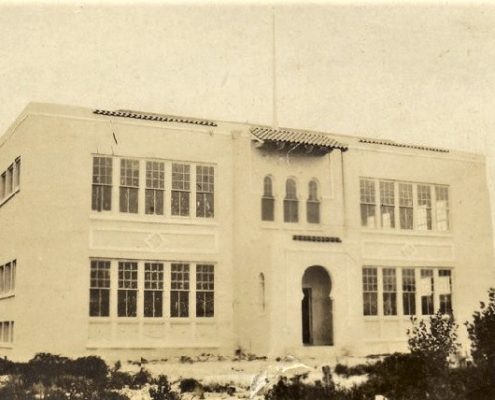
The Davie School, 1918.
The Davie School was dedicated on May 10, 1918 and at the dedication ceremony, Charles Walsh, an early orange grove owner arriving in 1914 and active Davie resident in all the community affairs, accepted the building on behalf of the town saying:
“We accept and thank you for this splendid building, a building no matter how large and important this community may grow, will ever be the center of its social action and the main cause of any progress we may make. The citizens of Davie will take pride in it, maintain it, and cherish it.”
And if that’s not the most perfect quote to sum up the school today, I don’t know what is. This is basically our mission statement. It is still relevant to what we hope we can still achieve today.
A Growing and Changing School
The school opened in 1918 with 90 students! These students were made up of families farming in Davie –some permanent residents, some only seasonally and they would return to their homes in the north for part of the year; and others were children of men working on the drainage project operating the dredges, building the canals, who brought their families with them. The population of the school was constantly changing here at the time.
The population of the students of the school at the time were white, though the town itself was more diverse. Segregation was followed at this time and the nearest school for black children would have been the Dillard School in Ft. Lauderdale. Because that would have been a hardship for the families in Davie, a school was organized by the black community in what is Potter Park today. This is definitely something we are doing research on and hope to expand on more in the future. We do know that by the 1950s, black students began attending Davie Elementary, and we want to know more about what that experience was like and if you know someone locally, please reach out to me. This is still a story we are hoping we can tell here.
The school went from the first through the eighth grade and in 1918, there were only three teachers. That meant about 30 students in each room, grades sharing spaces together and no air conditioning. That’s the hard part for me, how did they get a packed room of kids in hot sweaty space to pay attention. Amazing job teachers. I don’t know how you did it
But the school had been designed by August Geiger to stay cool—big windows let in light and air with transoms above the doors that allowed the air to flow into the hallway, and it was built from poured concrete, which besides from making it sturdy, trapped cooler air overnight to help stay a little cooler. There were also ventilation windows at the base of the school to let air flow under as well. You can see them in pictures today, but they are no longer there. The school was built a little higher than it appears today to help with flooding and that air flow. The building wouldn’t have electricity until 1923, but it was high tech because it had (drum roll) indoor bathrooms! The students most likely did not have that at home, so can you imagine the luxury of using a bathroom inside a building, and not in a little wooden shack 100 yards from your house! A cistern to the rear of the school caught rainwater to provide water for the plumbing that operated on a septic tank, so it was pretty high-class stuff for the time!
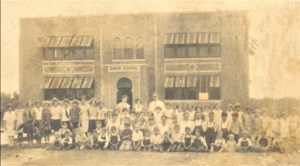
Students and Teachers of the Davie School, 1929. Mrs. Althea Jenne is the teacher standing in front of the Davie School keyhole entrance.
The keyhole entrance you see today was a signature of the architect’s Mediterranean style. He designed a few other buildings that have similar features— the Fort Lauderdale Women’s Club downtown and the Dade County Courthouse, both buildings are still there on their original locations. As the school population grew, additional buildings were built to the west—a cafetorium which serves as our office today. It provided a cafeteria for the school and also a large stage for school plays. A library to the east and more classrooms to the north and front of the school and the keyhole entrance was squared out and lost. The school continued to grow—adding four more classrooms upstairs in the auditorium and additional portables in the back. Kindergarten was added, and the middle grades moved to other junior high schools, ultimately leaving Kindergarten through 5th grade at Davie Elementary. By 1978, a new school building was built in downtown Davie and the students moved there. Griffin Elementary used the site for two years as an annex for overcrowding. But by 1980, the space became school board offices.
Looking into a New Century
And then the future of the school was unknown. The county intended on building new offices in Ft. Lauderdale, and there was consideration that the school would be torn down like many other historic buildings in south Florida. Thankfully, the local women’s volunteer group, Soroptimist International of Davie, recognized the need to protect the site and made it their project to restore and have the building placed on the National Register of Historic Places. The school board sold the site to the town of Davie for $1. With fundraising and rallying efforts that went all the way to the capital in Tallahassee, the Davie School Foundation Inc. was formed and successfully had the school listed in 1988.
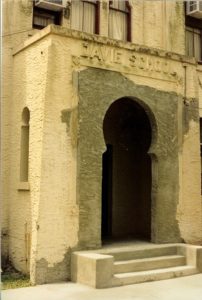
August Geiger’s original keyhole entrance restored, 1990s.
Restoration of the school began, the newer buildings that were not in great shape were torn down. The keyhole entrance returned to the façade of the school, cubicles and orange carpet were removed, and the beautiful original Dade County pine floors were revealed. The Foundation began collected the history of the town through photographs and artifacts and developed a museum of the history of the town that has continued to grow, telling the broad and amazing story of Davie.
Today, our school is a place for former students to return and remember their school days; it’s a place for new students, young and old, to learn about the community around them; it’s a community center that hosts programs, art shows, weddings, recitals, graduations, baby showers. It’s a centerpiece to remind the ever-changing town of Davie of where it came from and who contributed throughout those years. We hope we stand by Walsh’s words from that dedication 102 years ago— “The citizens of Davie will take pride in it, maintain it, and cherish it.”
There are more stories in between all those facts that we hope to share with you on this podcast! Stay tuned for more history and interviews. Schedule your tour of the old school and see history up close! Be safe and we’ll see you soon! Take care!

